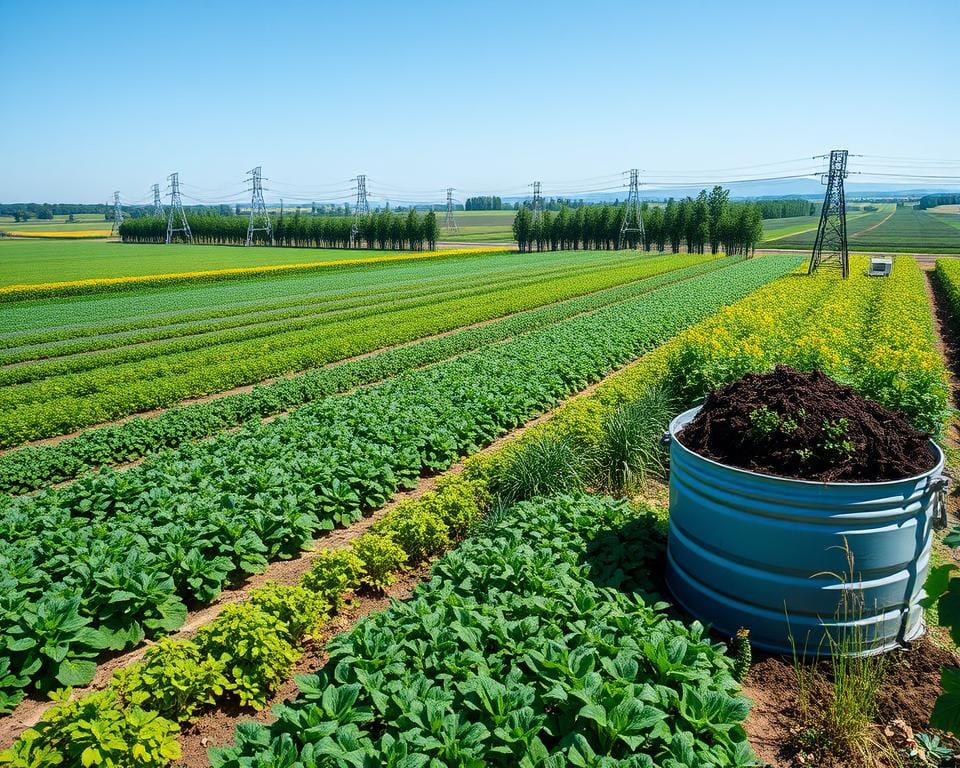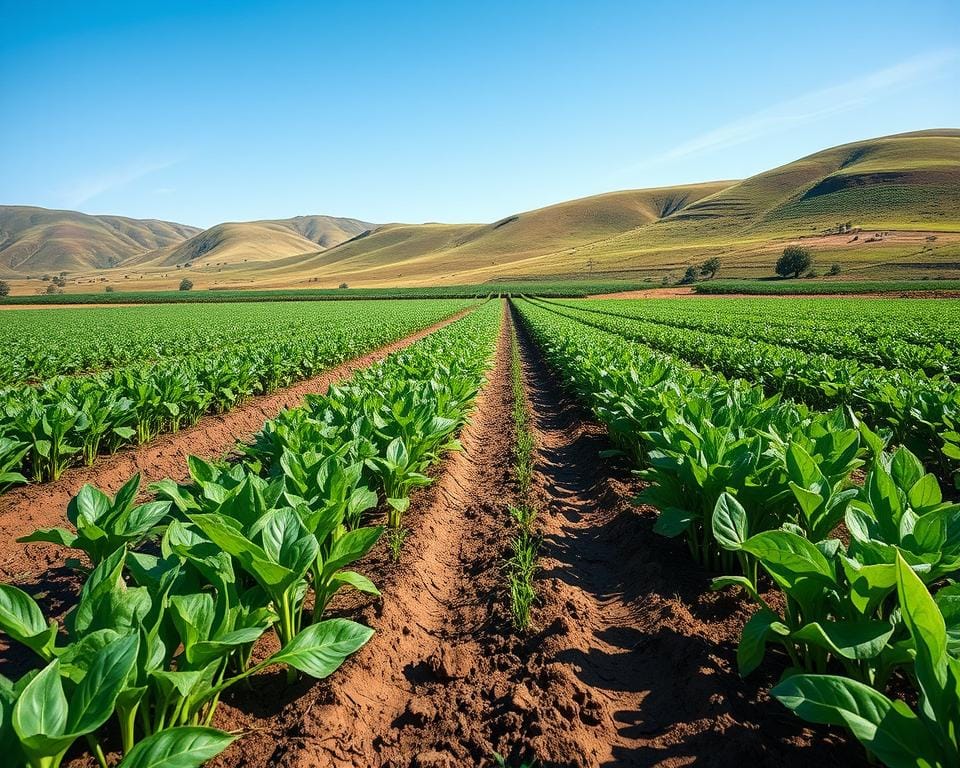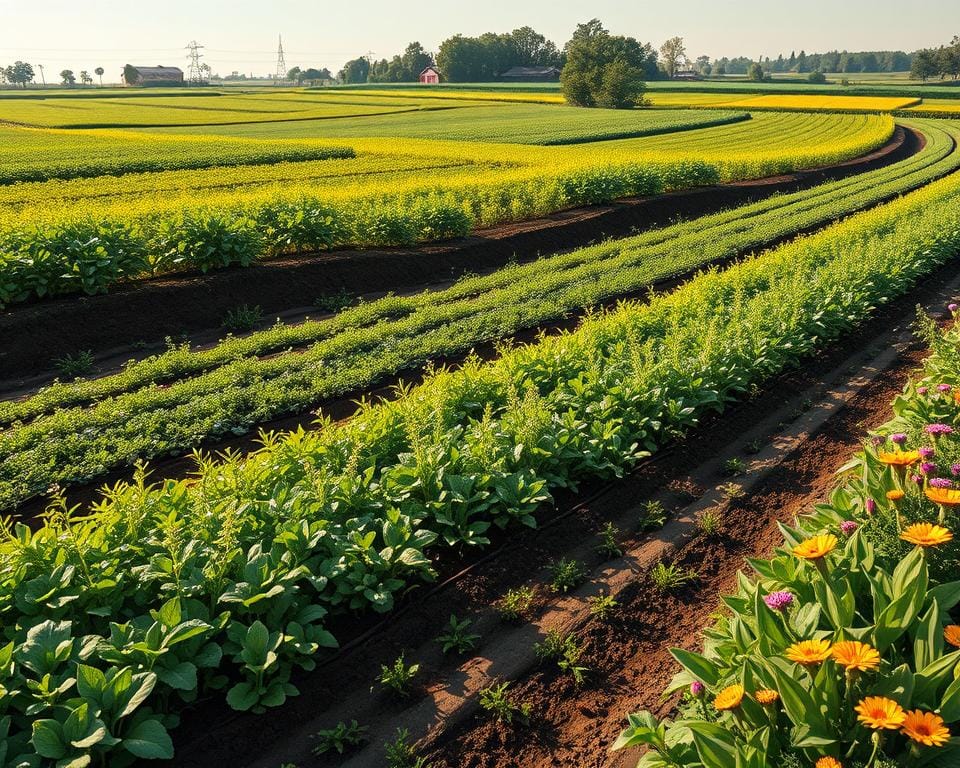Agricultural water runoff is a big problem we can’t ignore. It affects the quality of water in rivers, lakes, and wetlands. It also hits the economy hard. The United States spends over $4.8 billion each year just to remove nitrates from drinking water. So, it’s clear we need sustainable farming and ways to stop this pollution.
Each year, farmers in the U.S. use about half a million tons of pesticides. They also use 12 million tons of nitrogen and 4 million tons of phosphorus as fertilizers. This runoff can create “dead zones” in places like the Gulf of Mexico. These zones cover over 6,000 square miles. They hurt marine life and can even kill lots of fish. Runoff can also cause algal blooms, making it hard for aquatic life to survive.
We must tackle these environmental issues to keep ecosystems balanced and food production sustainable. Effective steps include managing nutrients well, using conservation tillage, and planting cover crops. Adding vegetative buffer strips, making wetlands, and managing pests can also help. These practices keep farming sustainable and prevent water pollution.
Understanding Agricultural Water Runoff
Agricultural water runoff is a big issue. It sends harmful things like fertilizers, pesticides, and animal waste into our waters. This harms the water quality and is dangerous for people and sea life. We need to look closely at what causes this and what it does.
Definition and Causes
Runoff in farming is water leaving fields, carrying bad stuff with it. The main reasons for water pollution from farms are not using fertilizers and pesticides properly, leaving animal waste around, bad soil handling, and watering crops the wrong way. For example, sugarcane farms in Queensland send runoff into the ocean. This harms sea life with too many nutrients and pesticides.
In the U.S., farms use lots of chemicals each year. They use 500,000 tons of pesticides, 12 million tons of nitrogen, and 4 million tons of phosphorus on crops. These chemicals make a dead zone in the Gulf of Mexico. It’s over 6,000 square miles big because of nutrient runoff from the Mississippi River Basin.
Environmental and Economic Impacts
The bad effects of farm runoff are huge. One big problem is nutrient pollution. It makes too much algae grow, which uses up oxygen and creates dead zones. The dead zone in the Gulf of Mexico harms fish and local fishing jobs. Pesticides also hurt water animals and can mess with their hormones.
For people, this runoff is dangerous too. Nitrates from fertilizers can get into drinking water, causing serious health problems like blue baby syndrome. Regular contact with pesticides like glyphosate and atrazine has been linked to serious health issues. The Walkerton crisis showed how animal waste runoff can make people very sick with E. coli.
Keeping water clean from nitrates costs the U.S. over $4.8 billion each year. This shows we need better farming ways. Techniques like switching crops, planting cover crops, and plowing less can lower chemical use. They also help stop soil from washing away. This can reduce the damage from farm runoff.
Proper Nutrient Management
Managing nutrients correctly is key to keeping our waterways healthy and farming sustainably. This includes balanced fertilizer use and soil testing. These methods help farmers keep nutrients in fields and boost crop growth.
Balanced Fertilizer Application
Balanced fertilizer use is crucial for sustainable farming. By matching fertilizer types and amounts to what crops need, farmers can reduce extra nutrients. This limits pollution from nutrient runoff. The 2022 Chesapeake Bay and Virginia Waters Clean-up Plan showed that 35,531 Best Management Practices reduced nitrogen runoff by 336,177 pounds annually.

Farmers can also apply fertilizers more than once per season. This matches the crop’s growth stages, preventing leaching into waterways. Slow-release fertilizers release nutrients over time, helping to limit runoff.
Including cover crops in farming is beneficial too. With 38.5% of Virginia’s cropland using cover crops, it’s a popular method. Cover crops absorb extra nutrients, preventing pollution of waterways.
Soil Testing and Monitoring
Regular soil testing is essential for nutrient management. It tells farmers about the soil’s nutrient levels and pH. With this info, they can adjust fertilizer use to support sustainable farming.
Soil tests prevent using too much fertilizer, which can pollute the environment. Keeping an eye on soil health helps make nutrient use efficient and eco-friendly.
Technological tools have also improved soil management. For example, the cover crop nitrogen calculator helps predict nitrogen from cover crops. It uses data from 28 states, benefiting farmers in the Chesapeake Bay area.
Farmers should consult experts and use resources like automated soil tests. This can improve nutrient management, making it more precise and effective.
Using the right nutrient management methods reduces pollution and supports healthy ecosystems. It prevents harmful algal blooms and aids aquatic life. This approach makes nutrient management a core part of modern farming, good for both the environment and farmers.
Discover more about nutrient runoff prevention and soil testing importance here.
Conservation Tillage Methods
Conservation tillage, like no-till and strip-till, is key in saving soil in farming. They leave behind crop remains on the ground. This action helps prevent soil erosion, boosts water seepage, and betters soil health.
No-till farming keeps the ground untouched, greatly cutting down soil wash away. It conserves soil in agriculture. The leftover crop cover guards the soil against rain, lowering runoff and dirt movement. Plus, no-till boosts soil organic matter, making it richer and more fertile.
Strip-till is another low-till farming way, affecting only the seed row soil. This leaves the soil between rows untouched, aiding in stopping soil erosion. It keeps soil structure intact, improves water seepage, and decreases nutrient loss. Strip-till supports both soil saving and eco-friendly farming.
Moreover, conservation tillage cuts down on heavy plowing. This means less fuel use and lower carbon emissions. By using these methods, farmers fight soil erosion and push for ongoing sustainable farming.
For those into efficient and green water use in farming, adopting conservation tillage is vital. Check out this link for more on water-smart crops.
Using Cover Crops to Prevent Erosion
Using cover crops is a smart way to stop erosion and help farms last longer. These plants do a lot of good, like making soil healthier and cutting down on runoff. Let’s look closely at why these crops are so helpful and the different kinds out there. We’ll also check out some real-life stories and studies in this area.
Types of Cover Crops
Different cover crops do different things for stopping erosion. For example, grasses like cereal rye and oats cover the soil well. Legumes, such as vetch and clover, help with nutrients in the soil. Brassicas, like radishes, break up tight soil and add nitrogen. Each cover crop offers its own special benefit to farming.

Benefits of Cover Crops
Cover crops bring big wins for farming. They can cut nitrogen washing away by as much as 60%. They also reduce phosphorus losses by up to 95%, studies by Abdalla et al., (2019) show. They even help soil hold more water, increasing rates by 33% (Blanco-Canqui et al., 2011).
What’s more, cover crops can cut pollution from farms reaching water underground by half (Hargrove et al., 1991). These perks lead to a healthier environment and more money for farms. Research shows that cover crops can up net earnings per acre.
Case Studies and Research
Iowa State University’s work shows how cover crops cut down soil loss and runoff by about 30%. The FAO has found that soils farmed without plowing see 90% less erosion than normal plowed fields. Also, according to Blanco-Canqui et al., (2011), cover crops make soil better physically.
A further study by Hughes & Langemeier (2020) in central Indiana found that cover crops boosted profits by up to $100 per acre. These success stories and data points highlight both the economic and environmental advantages of using cover crops to fight erosion.
Establishing Vegetative Buffer Strips
Vegetative buffer strips are made up of grasses, trees, or shrubs. They play a key role in agriculture’s riparian buffers. Strategically planted along waterways, they filter runoff, capturing sediments and pollutants. This prevents them from entering the water system. Through streamside management, farms can greatly improve water quality and reduce soil erosion.
Vegetative buffers can decrease sediment runoff by up to 80%. This helps control soil erosion well. They also absorb up to 60% of nitrogen and phosphorus pollutants. This leads to notable improvements in water quality. The success of these buffers depends on their width and density. For instance, wider buffers, over 100 feet, better filter pollutants like nitrogen. Yet, even narrow buffers around 15 feet provide good stream bank protection.
Adding vegetative buffers increases local biodiversity, providing homes for various plants and animals. This can increase biodiversity by up to 30%. Farms with these buffers often see a 15% increase in curb appeal and market value. So, it’s not only good for the environment but also profitable.
Starting vegetative buffers can cost $2,000 to $5,000 per acre. This includes the cost for plants and labor. They need 1 to 10 feet of land width to work, suitable even for small areas. The USDA suggests using a three-zone approach for best results:
- Zone 1 – Undisturbed forest area
- Zone 2 – Managed forest area
- Zone 3 – Grassy area for runoff control
Implementing riparian buffers helps reduce land erosion and problems from cattle grazing near streams. Issues like soil compaction and water contamination can be mitigated. Good streamside management includes identifying and preparing sites, choosing and planting vegetation, and maintenance. It might involve fencing installation too. There are government programs to help with costs. By taking these steps, farmers can create effective vegetative buffers. This ensures lasting benefits for both the environment and the economy.
Constructed Wetlands for Runoff Filtration
Constructed wetlands are a green way to clean agricultural runoff. They copy what happens in nature to remove bad stuff like nitrogen and phosphorus from water. This helps solve big problems, like the “dead zone” in the Gulf of Mexico, now over 3,000 square miles big.
How Constructed Wetlands Work
Constructed wetlands clean water using three methods: physical, chemical, and biological. There are two main types: Surface Flow Constructed Wetlands (SFCWs) look like natural wetlands, and Subsurface Flow Constructed Wetlands (SSFCWs) have water flow under the ground through materials like gravel. These methods are great at taking out harmful nitrates and phosphorus.
Benefits to Aquatic Ecosystems
These man-made wetlands are great for water life. They lower the nutrients that cause too much phytoplankton, which has gone up globally by 13%. Wetlands are homes for animals and help stop floods by holding water. They turn nitrogen into a harmless gas and trap phosphorus in mud, helping a lot.
Successful Implementations
Many places have built wetlands successfully. Illinois uses them to try and cut nutrient loss by 45% by 2025. But, levels of nitrate and phosphorus are still going up. Still, these systems are doing well in cleaning different kinds of water and they’re not too expensive. They cost between $30,000 and $80,000. Plus, new technologies like the French Filter System are good at cleaning sewage and cutting down on methane and sludge.
Integrated Pest Management (IPM)
IPM approaches in agriculture are very important. This method uses biological, cultural, and chemical ways for sustainable pest control. It also aims to use fewer pesticides and reduce pesticide runoff. Doing this helps protect pollinators and our environment, making farms more sustainable.
IPM helps avoid pests becoming resistant to pesticides. Regular monitoring is key for knowing pest levels and damage. By setting action thresholds, we know when to start pest control. Using native predators and biological control can manage pests well. This supports sustainable pest management.
Choosing methods and tools with the least risk boosts efficiency in reducing pesticide runoff and improving water quality. Properly labeling and applying pesticides ensures safety. Precision technologies target pests directly, minimizing outside impacts. Also, using vegetative buffers near pollinator habitats prevents drift.
Diverse pest control methods create a well-rounded strategy. Options like fatty acids, insecticidal soaps, and homemade solutions work well against soft-bodied insects. For crop seed treatments, minimizing drift and runoff is crucial. Advice from the USDA, local groups, and extension offices is very helpful for IPM success.
IPM uses many control methods: cultural, mechanical, biological, and chemical. Cultural controls involve soil prep, crop rotation, choosing native plants, and watering right. Mechanical methods like weeding, pruning, mulching, and barriers are important too. Biological strategies boost beneficial organisms to naturally control pests.
- Integrated Pest Management (IPM) reduces risks to pollinators, the environment, and people.
- Cost savings and time efficiency in managing pest issues sustainably.
- Regular monitoring for effective pest control.
Using pesticides correctly, considering wind and temperature, minimizes harm to pollinators. Choosing liquid sprays or granules over dust lessens risks. IPM’s sustainable pest management is about smartly combining strategies for a healthier agricultural ecosystem.
Conclusion
It’s crucial to address the issue of agricultural water runoff. Doing so protects our water resources and ensures the well-being of ecosystems and communities. Innovative and sustainable farming methods can greatly cut down the negative effects of runoff. This article has looked into top practices for preventing water runoff. These include proper use of nutrients, using conservation tillage, planting cover crops, setting up vegetative buffer strips, and managing pests wisely.
These methods don’t just improve water quality; they also boost the economy. They do this by increasing crop yields and lowering the cost of inputs. For example, creating wetlands can cut nitrogen in runoff by almost 50% and phosphorus by up to 81%. These numbers show how effective it can be to incorporate these practices into our farming.
To build a sustainable future in agriculture, we need to start using these tested methods. By applying these water runoff prevention techniques and making use of conservation funding like the Farm Bill, we can develop a strong, eco-friendly agricultural system. This system would support both high productivity and care for the environment. The move towards a sustainable and water-wise approach to farming is in our hands.

